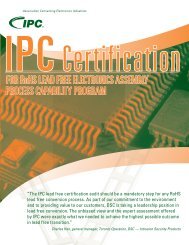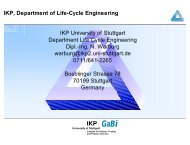RoHS Compliance Process
RoHS Compliance Process
RoHS Compliance Process
Create successful ePaper yourself
Turn your PDF publications into a flip-book with our unique Google optimized e-Paper software.
<strong>RoHS</strong> <strong>Compliance</strong> <strong>Process</strong><br />
EICTA’s view<br />
Dr. Ralph Jäger<br />
EICTA <strong>RoHS</strong> Issue Manager<br />
Sony Deutschland GmbH<br />
1
EICTA<br />
EICTA is the voice of the Information and Communications<br />
Technology and Consumer Electronics Industry in Europe<br />
Facts and figures<br />
EICTA combines 51 major multinational companies and 32<br />
national associations from 24 European countries. In all, EICTA<br />
represents more than 10,000 companies all over Europe with more<br />
than 2 million employees and EUR 200 billion in revenues.<br />
2
Table of contents<br />
• Status based on Commission text<br />
• Goal to define a practical, harmonized, and costeffective<br />
approach<br />
• Principles for existing environmental legislation<br />
• EICTA proposal on the enforcement process<br />
• Harmonized approach for testing<br />
• Conclusions<br />
3
Status<br />
Member States shall ensure that, from 1 July 2006, new electrical and electronic<br />
equipment put on the market does not contain lead, mercury, cadmium, hexavalent<br />
chromium, polybrominated biphenyls (PBB) or polybrominated diphenyl ethers<br />
(PBDE). National measures restricting or prohibiting the use of these substances<br />
in electrical and electronic equipment which were adopted in line with Community<br />
legislation before the adoption of this Directive may be maintained until 1 July<br />
2006.<br />
à No specifications about the <strong>RoHS</strong> compliance<br />
process/market surveillance are made.<br />
4
Goal<br />
Define a practical, harmonized, and costeffective<br />
approach for a <strong>RoHS</strong> <strong>Compliance</strong><br />
<strong>Process</strong> that ensures conformance to the<br />
Directive and is not overly burdensome for<br />
either the Member States or Industry.<br />
5
Product-related environmental legislation in Europe<br />
1. Principles of existing market access in the EU<br />
• Guarantee of the free movement of electronic and electrical products<br />
within the EU;<br />
• No third party verifications;<br />
• No declarations are required in order to place a product onto the EU<br />
market.<br />
2. Principles of enforcement practise in the EU<br />
• Based on ad hoc checks by national market surveillance authorities in<br />
coordination with other EU countries (efficient market surveillance to<br />
fight free-riders - i.e. non compliant products put on the market).<br />
• Transparent and predictable process is of utmost importance.<br />
6
EICTA Proposal: General Principles for the<br />
Enforcement <strong>Process</strong><br />
• To ensure compliance, producers<br />
– can use various approaches (see later slide) based on quality<br />
assurance processes and/or technical documentation, that ensure<br />
that non-compliant materials do not enter the manufacturing<br />
process.<br />
• To verify compliance, market surveillance authorities<br />
– should verify that the producer has adequate control processes by<br />
evaluating control documentation (based on quality assurance<br />
process and/or technical documentation).<br />
– If such processes do not exist or severe concern exists, then testing<br />
of specific part(s), or material(s) should be carried out by market<br />
surveillance authorities.<br />
7
EICTA proposal for the <strong>RoHS</strong> compliance process<br />
Common<br />
understanding<br />
of enforcement<br />
process<br />
4. In case of severe<br />
concern,<br />
verification through<br />
testing by authorities<br />
3. Assessment of self-declarations and,<br />
if needed, other supportive<br />
documentations<br />
by market surveillance authorities<br />
2. Self-declaration by producers on request by<br />
authorities*<br />
*Based on quality assurance processes or technical<br />
documentation<br />
Sampling<br />
(homogeneous<br />
material)<br />
to be<br />
clarified<br />
IEC<br />
Standard<br />
Test<br />
Methods<br />
1. Presumption of conformity upon placing on the market<br />
8
Why quality assurance system based control approach?<br />
Example: Number of Certificates for a product with 500 parts<br />
PRODUCT 1<br />
Part 1<br />
Part Supplier 1<br />
Part 2 ... Part 500<br />
Part Supplier 2 Part Supplier 3<br />
500<br />
1500<br />
Material Suppier 1 Material Supplier 2<br />
Material 1 Material 2 Material 3 Material 4<br />
Pb Cd Hg Cr(VI) PBB PBDE<br />
3000<br />
12000<br />
72000<br />
à<br />
No technical documentation for each substance in each<br />
homogeneous material in each part should be required!<br />
9
Quality assurance system based <strong>RoHS</strong> <strong>Process</strong> Control<br />
A producer must ensure its suppliers have control<br />
processes in place that DO NOT allow noncompliant<br />
material to enter the manufacturing<br />
process.<br />
Control <strong>Process</strong><br />
•Material specifications<br />
•Material documentation<br />
•Material tracking<br />
•Material testing (as required)<br />
•Manufacturing process<br />
“Clean”<br />
Materials<br />
In<br />
“Clean”<br />
Product<br />
Out<br />
à<br />
Suitable tool to ensure and demonstrate compliance<br />
without going into detailed technical documentation<br />
10
EICTA proposal for control documentation<br />
Quality Assurance<br />
System<br />
(producer describes<br />
process)<br />
AND<br />
/OR<br />
Technical Documentation<br />
(producer provides<br />
technical documentation)<br />
Producer<br />
1<br />
Product level<br />
Part 2supplier<br />
Parts level<br />
“Clean”<br />
Product<br />
Supplier<br />
Commitment<br />
“Clean”<br />
<strong>Process</strong><br />
Contracts with suppliers<br />
setting requirements<br />
Random testing of<br />
incoming parts and end<br />
products<br />
Contracts with suppliers<br />
setting requirements<br />
Random testing of<br />
incoming materials and<br />
finished parts<br />
Producer´s ‘declaration of<br />
compliance’<br />
Due to number of certificates only<br />
workable on request for selected parts<br />
Component supplier´s<br />
‘declaration of compliance’<br />
Based on data for raw materials used<br />
for the parts in question<br />
Raw 3material<br />
supplier<br />
Materials level<br />
Supplier<br />
Commitment<br />
“Clean“<br />
Raw Material<br />
Measurement<br />
data for<br />
materials<br />
Raw material supplier´s<br />
‘declaration of compliance’<br />
Based on raw material data<br />
11
Market Surveillance Testing – Harmonized<br />
Approach needed<br />
Producer<br />
Common<br />
understanding of<br />
test methods<br />
Market<br />
surveillance<br />
authority<br />
In order to be able to<br />
perform testing at final<br />
products there has to be<br />
agreement on testing<br />
requirements<br />
(international standards<br />
like IEC would be<br />
preferred).<br />
Parts<br />
Supplier<br />
Raw<br />
material<br />
supplier<br />
Testing methods need to<br />
be practical for final<br />
products and parts<br />
(reasonable sampling<br />
methods).<br />
12
Conclusions<br />
A practical approach for a <strong>RoHS</strong> <strong>Compliance</strong> <strong>Process</strong> that ensures<br />
conformance to the Directive and is not overly burdensome for<br />
either the Member States and Industry is needed:<br />
– Guarantee the free movement of electronic and electrical products within<br />
the EU (harmonized national implementation)<br />
– No third party verifications.<br />
– Not require a declaration in order to place a product onto the EU market.<br />
– Have producers show conformance with ‘self-declaration of compliance’.<br />
– Consistent enforcement across the EU - Cooperation between member<br />
states and industry on the enforcement system is essential.<br />
– Work towards a common understanding of test methods.<br />
– Ensure common understanding of practical sampling methods.<br />
13
BACKUP<br />
14
Producers' self-declaration<br />
Demonstrating conformance within enforcement process<br />
Formal request by a market surveillance authority to a producer<br />
Producers' self-declaration<br />
Based on EMS, covering level 1-3 docu<br />
NO concern<br />
Concern *<br />
Producers' self-declaration<br />
Selected parts, level 2 docu<br />
Concern *<br />
Producers' self-declaration<br />
Selected raw materials, level 3 docu<br />
Producers' self-declaration<br />
Based on technical documentation, level 1-2<br />
Concern *<br />
NO concern<br />
NO concern<br />
NO concern<br />
Drop<br />
the<br />
case<br />
Severe CONCERN<br />
Enforcement authority tests product<br />
NO concern<br />
PROVEN non-compliance<br />
Enforcement authority informs the producer immediately of non-compliance and both parties<br />
engage in a formal and transparent resolution process.<br />
<strong>Process</strong> to solve the problem starts.<br />
The rights and obligations of authorities and producers must be clearly defined.<br />
* Formal request by a market surveillance authority to a producer to provide further clarifications (level 2/3 documentation as needed)<br />
Level of documentation may very depending if the request is for a general verification of compliance or a specific concern regarding a<br />
potential compliance issue.<br />
15
EICTA<br />
Diamant Building<br />
80, Boulevard A. Reyers<br />
1030 Brussels - Belgium<br />
Tel: 0032.2.706.84.70 Fax: 0032.2.706.8479<br />
E-mail: info@eicta.org<br />
Website: www.eicta.org





